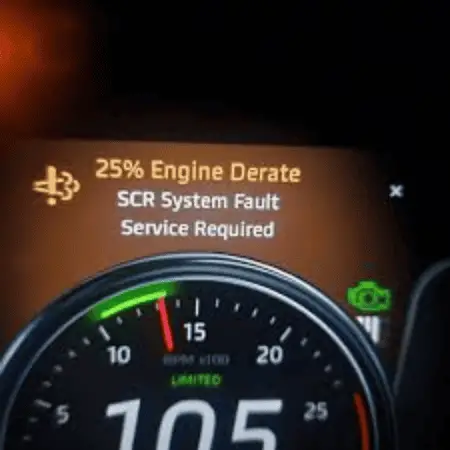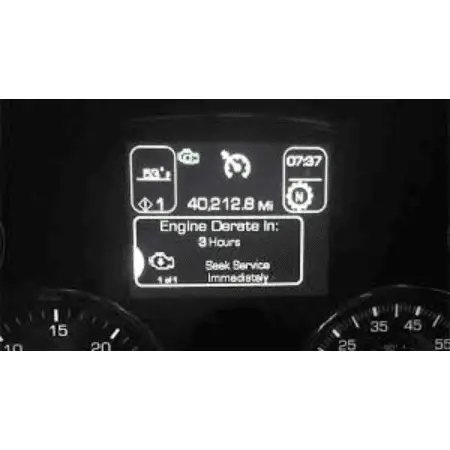Engine derate can be frustrating for many drivers, causing a loss of power and efficiency in their engines. Understanding the causes and knowing how to clear engine derate is essential for maintaining optimal performance. In this article, we’ll delve into the various aspects of engine derate, and its symptoms, and provide a step-by-step guide on how to clear it effectively. So keep on reading…
How to clear engine derate? To clear engine derate, first, check for any warning lights on your dashboard and look for any obvious signs of damage or leaks under the hood. Then, try turning off the engine and restarting it to see if the issue resolves itself. If not, ensure the air filters are clean and check the fuel and oil levels. If everything seems okay, it’s best to consult an auto mechanic to diagnose and fix the problem. Regular maintenance and keeping an eye on your vehicle’s performance can help prevent engine derates in the future.

What is Engine Derate?
“Engine derate means the engine is not working as well as it should. It might be running slower or with less power than normal.”
When an engine is in a state of derate, it means that it’s not performing at its optimal level. Normally, it’s trained to run fast and smoothly. Your vehicle might feel sluggish when you press the gas pedal as if it’s struggling to accelerate. You might notice that it takes longer to reach the desired speed, or that it struggles to maintain speed, especially when going uphill or carrying a heavy load.
Must Read
- Can Low Oil Cause Misfire? Explained In Detail
- What Should Wheel Bearing Seals Be Checked For?
- How To Know If Blend Door Actuator Is Bad? Signs & Diagnosis
Causes of Engine Derate
Mechanical Issues:
Engine derate can occur due to mechanical issues such as dirty air filters, clogged fuel injectors, or problems with the exhaust system. These mechanical issues can hinder the engine’s performance and lead to a decrease in power output.
Fuel System Problems:
Issues with the fuel system, such as low fuel pressure or restricted fuel flow, can also cause engine derate. Clogged fuel filters or malfunctioning fuel pumps may prevent the engine from receiving an adequate supply of fuel, resulting in reduced performance.
Overheating:
Overheating of the engine can trigger derating as well. Problems with the engine’s cooling system, such as coolant leaks or malfunctioning cooling fans, can lead to overheating. When the engine becomes too hot, it may automatically reduce power output to prevent damage.
Electronic Control Module (ECM) Malfunctions:
Malfunctions in the electronic control module (ECM), which controls various aspects of the engine’s operation, can also result in engine derate. Faulty sensors or ECM software glitches may cause the engine to operate at a reduced power level as a safety measure. Troubleshooting and repairing ECM issues are crucial to restoring the engine’s performance.
Signs of Engine Derate:
Loss of Power: One of the most common signs of engine derate is a noticeable decrease in engine power. The vehicle may struggle to accelerate or maintain speed, even under normal driving conditions.
Reduced Speed: Engine derate can cause the vehicle to operate at lower speeds than usual, even when the accelerator is fully engaged. This reduction in speed can impact the vehicle’s performance and responsiveness.
Warning Lights: Warning lights on the dashboard, such as the check engine light or a specific engine fault indicator, may illuminate when the engine experiences derate. These lights serve as a signal that there is a problem with the engine or its components that needs attention.
Increased Fuel Consumption: Engine derate can lead to an increase in fuel consumption as the engine works harder to maintain performance despite reduced power output. Drivers may notice that their vehicle requires more frequent refueling or experiences a decrease in fuel efficiency compared to normal operation.

Step-by-Step Guide to Clear Engine Derate:
Clearing engine derate is vital to restore optimal engine performance and prevent potential damage. Ignoring derate warnings can lead to further complications and costly repairs in the long run.
1- Check Dashboard Lights:
Begin by checking for any warning lights on the dashboard, such as the check engine light or other engine fault indicators. These lights can provide valuable information about the nature of the derate and help guide troubleshooting efforts.
2- Inspect Under the Hood:
Pop the hood and visually inspect the engine and surrounding components for any signs of damage, leaks, or loose connections. Pay close attention to areas such as the air intake system, fuel lines, and coolant hoses.
3- Restart the Engine:
Turn off the engine and wait for a few minutes before restarting it. Sometimes, simply restarting the engine can clear temporary issues causing the derate. Pay attention to any changes in engine performance after restarting.
4- Check Air Filters:
Dirty or clogged air filters can restrict airflow to the engine, leading to reduced performance and derate. Remove the air filters and inspect them for dirt, debris, or damage. Clean or replace the filters as needed.
5- Inspect Fuel System:
Check the fuel system for any issues such as low fuel pressure, clogged fuel filters, or fuel leaks. Ensure that the fuel tank is adequately filled and that there are no obstructions in the fuel lines.
6- Inspect Cooling System:
Overheating can trigger engine derate. Check the engine coolant level and inspect the cooling system for leaks, damaged hoses, or malfunctioning cooling fans. Address any issues promptly to prevent overheating.
7- Check for Faulty Sensors:
Faulty sensors, such as those monitoring air intake, fuel pressure, or engine temperature, can cause incorrect readings and trigger engine derate. Use diagnostic tools to scan for error codes and identify any faulty sensors.
Preventive Measures to Avoid Engine Derate
To avoid engine derate in the future, consider the following preventive measures:
- Conduct regular maintenance checks, including inspections of all engine components.
- Use high-quality fuel and ensure the fuel system is kept clean and free from contaminants.
- Maintain the coolant system to prevent overheating issues.
- Keep the ECM up-to-date with software upgrades and updates.
You May Find Helpful
- Why My Car Won’t Accelerate But RPMs Go Up? Explained
- Why All My Gauges Stopped Working While Driving & What To Do?
- Airbag Light Comes On And Off While Driving – Reasons & Solutions
Conclusion
Clearing engine derate is essential for restoring engine performance and preventing further damage. By understanding the causes, recognizing the symptoms, and following the step-by-step guide provided in this article, vehicle owners can effectively address engine derate issues and ensure optimal engine operation.
